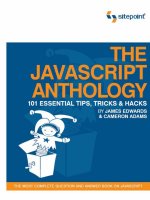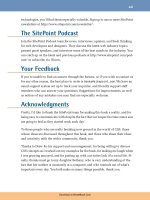The javascript anthology 101 essential tips tricks hacks - phần 9 potx
Bạn đang xem bản rút gọn của tài liệu. Xem và tải ngay bản đầy đủ của tài liệu tại đây (377.43 KB, 16 trang )
targetTable.replaceChild(newTbody, targetTbody);
stopDefaultAction(event);
return false;
}
The first for loop that occurs after all the structural variables have been defined
sets the respective states for each of the table heading cells when one of them is
clicked. Not only are classes maintained to identify the heading cell on which
the table is currently sorted, but a special sortOrder property is maintained on
each cell to determine the order in which that column is sorted. Initially, a column
will be sorted in descending order, but if a heading cell is clicked twice consecut-
ively, the sort order will be changed to reflect an ascending sequence. Each
heading cell remembers the sort order state it exhibited most recently, and the
column is returned to that state when its heading cell is re-selected. The title
of the hyperlink for a clicked heading cell is also rewritten depending upon the
current sort order, and what the sort order would be if the user clicked on it again.
The second for loop sorts each of the rows that’s contained in the body of the
table. A copy of the original tbody is created to store the reordered table rows,
and initially this copy is empty. As each row in the original tbody is scanned, the
contents of the table cell in the column on which we’re sorting is compared with
the rows already in the copy.
In order to find the contents of the table cell, we use the function
getInternalText:
File: sort_tables_by_columns.js (excerpt)
function getInternalText(target)
{
var elementChildren = target.childNodes;
var internalText = "";
for (var i = 0; i < elementChildren.length; i++)
{
if (elementChildren[i].nodeType == 3)
{
if (!/^\s*$/.test(elementChildren[i].nodeValue))
{
internalText += elementChildren[i].nodeValue;
}
}
263Order the print version of this book to get all 588 pages!
Sorting Tables by Column
else
{
internalText += getInternalText(elementChildren[i]);
}
}
return internalText;
}
getInternalText extracts all of the text inside an element—including all of its
descendant elements—by recursively calling itself for each child element and
concatenating the resultant values together. This allows us to access the text inside
a table cell, irrespective of whether it’s wrapped in elements such as spans,
strongs, or ems. Any text nodes that are purely whitespace (spaces, tabs, or new
lines) are ignored via a regular expression check.
When sortColumn finds a row in the copy whose sorted table cell value is “less”
than the one we’re scanning, we insert a copy of the scanned row into the copied
tbody. For a column in ascending order, we simply reverse this comparison: the
value of the row in the copy must be “greater” than that of the scanned row.
However, before a comparison is made, we check whether the contents of the
sorted table cell can be interpreted as an integer or a float; if so, the comparison
values are converted. This makes sure that columns that contain numbers are
sorted properly; string comparisons will produce different results than number
comparisons.
Once all of our original rows have been copied into the new tbody, that element
is used to replace the old one, and we have our sorted table!
Using the sortableDescending and sortableAscending classes, which are as-
signed to the currently sorted table heading cells, we can use CSS to inform the
user which column the table is sorted on, and how it is sorted, as shown in Fig-
ure 13.2 and Figure 13.3.
Order the print version of this book to get all 588 pages!264
Chapter 13: Basic Dynamic HTML
Figure 13.2. A sortable table sorted in descending order on the
fourth column
Figure 13.3. A sortable table sorted in ascending order on the
second column
265Order the print version of this book to get all 588 pages!
Sorting Tables by Column
Summary
The two main pillars of DHTML are the capturing of events, and the reorganiz-
ation and creation of page elements via the DOM. Using these principles, it’s
possible to capture many of the different ways that users interact with a page
and make the interface respond accordingly.
As can be seen by the number and quality of JavaScript-enhanced web applications
that are now available, the features DHTML can bring to new interfaces represents
one of the biggest growth areas for innovative JavaScript. The foundations and
basic examples shown in this chapter give you a sense of the power that it can
deliver inside a user’s browser. We’ll expand upon this further in the following
chapters as we build some really interesting interfaces.
Order the print version of this book to get all 588 pages!266
Chapter 13: Basic Dynamic HTML
What’s Next?
If you’ve enjoyed these chapters from The JavaScript Anthology:
101 Tips, Tricks & Hacks, why not order yourself a copy?
The JavaScript Anthology: 101 Tips, Tricks & Hacks is the ultimate
toolkit for web developers using JavaScript. It's a collection of over
100 thoroughly-tested, customizable, and elegant solutions that
will enable you to easily add usable and accessible interactivity to
your site.
As JavaScript guru Bobby van der Sluis says, “The JavaScript
Anthology is the cookbook of modern JavaScript, discussing only
best practice solutions—a useful, timesaving, and practical
reference for your desk."
The JavaScript Anthology: 101 Essential Tips, Tricks & Hacks also
includes download access to all of the best practice code samples
used throughout the book—plug them right into your own
projects without any retyping!
In the rest of the book, you’ll find solutions that will:
Search and replace text using regular expressions
Validate email addresses on your web forms
Make a slideshow of images
Make a style sheet switcher
Build an accessible drop-down menu system
Construct drag 'n' drop interfaces using AJAX
Use JavaScript and Flash together
Make your JavaScript accessible
Use XMLHttpRequest to build AJAX applications
Optimize your JavaScript code so that it runs faster
And much more!
On top of that, order direct from sitepoint.com and you’ll receive
a free 17” x 24” poster of your choice!
Order now and get it delivered to your doorstep!
Index
Symbols
!= inequality operator, 49
!== non-identity operator, 50
. wildcard character, 56
== equality operator, 48
=== identity operator, 50
A
abs method, Math class, 278
absolute positioning
browser differences, 248
CSS clip property and, 305
drop-down lists, 509
iframe elements, 357
menus, IE, 332
news ticker example, 299
abstraction
direct referencing and, 520
object orientation feature, 516, 522,
549
of tasks as functions, 548
Access Matters web site, 438
accessibility
(see also keyboard accessibility; screen
readers)
attempted definition of, 386
automatically initiated scripts, 441
current sub-branch display, 383
device-independent event handlers,
393–394
frames and, 135
hiding menu elements, 326
keyboard and mouse, 395–402
keyboard navigation and, 368
limitations of menus, 326
non-programming aspects, 387
popups and, 129
screen readers and, 436–456
slider controls, 428–436
tooltip display and, 402–411
ActionScript, 461
activate event, IE, 394, 397
:active pseudo-class, 325
ActiveX objects, 3, 468
(see also Flash; XMLHttpRequest
object)
Flash detection and, 458
Flash version detection, 460
FSCommand support and, 461, 463
memory leaks and, 556
actuate event, 393
addDomFunction function, 562
addEventListener method, 16, 234,
243, 560
addLoadListener function, 15
accessible tooltip example, 405
adding a new style sheet, 226
auto-complete text fields, 507
clip–based transitions, 306
custom dialog example, 483
drag-and-drop effects, 282
image swapping, 169
soccer ball animation, 272
tooltip example, 251
WYSIWYG editor, 492
addRule method, IE, 221, 226
AJAX (Asynchronous JavaScript and
XML), 468
frameworks, 476
keyboard accessibility, 401
screen readers and, 446
Ajile module, 532
alert dialog
error analysis and, 23
error messages, 119, 441
page alternative, 25
screen readers and, 449
all property, document object
accessible tooltip example, 405
browser detection and, 196
cleaning functions using, 558
elements by attribute value, 98
alternate style sheets, 207, 211–212
animated GIFs, 189
animation
achieving smoothness, 278–281
applicable Flash techniques, 278
automated slideshows, 173
drawing times, 280
frame rate changes, 279
optimization excluding, 536
realism in, 274
scrolling news ticker, 298–305
soccer ball example, 272–278
straight line movement, 270
transition effects, 305–311
anonymous functions
creating, 12
DOM method loading, 562
event handlers and, 232
inline declaration, 269
setInterval alternative, 273
W3C event model and, 238
antialiasing, 279
appendChild method, 88, 92
arguments collection, 547
arithmetic operators, 31–33
(see also Math class)
array-literals, 66
arrays, 65–78
adding or removing members, 72
alternate style sheets, 214
clock display, 183
code efficiency and, 550
collections similar to, 83
date and time comparisons, 164
Date object methods and, 153
drop-down menus and, 503
example, 67
forms collection as, 104
image preloading, 168
inverse sorting, 380
multi-dimensional arrays, 66, 76
radio button access, 110
select box access, 113
slideshow automation, 175
sorting, 75, 77
strings from, 71
writing debugging data to, 25
arrow keys
accessible drag-and-drop functional-
ity, 400
accessible slider control, 433
drop-down menus and, 508
key codes for, 424
keyboard accessible menus and,
391, 411, 421, 424, 426, 428
arrow submenu indicators, 334, 337
assistive technologies, 5
(see also screen readers)
associative arrays
Flash version detection, 460
forms collections as, 104
frames collections as, 136
asterisks
implying all elements, 405
in regular expressions, 56
tag name wildcards, 98
asynchronous processing
(see also AJAX)
load requests, 168
open method requests, 471
updates and accessibility, 442, 453
attachEvent method, IE
addEventListener and, 16, 234, 243
attachEventListener and, 330
checking for, 237
circular references and, 559
event object and, 334
Order the print version of this book to get all 588 pages!566
Index
load event and, 560
attachEventListener function, 234,
241, 243
accessible rollover example, 396
accessible tooltip example, 404
circular reference cleaning, 559
click events and, 367
drag-and-drop effects, 282
drop-down menu example, 327, 330
screen reader identification, 450
tooltip example, 251
attributes
accessibility under DOM 0, 96
copying, 93
reading and writing values, 95–98
reading unverified, 97
retrieving elements with given, 98–
100
auto-complete text fields, 502
automatic radix detection, 41
automatically initiated scripts, 441
B
back button problems, 479
background color slider, 317
background images, 168, 334
background masking, 486
background-color property, 488
back-references, 62
backslash escaping, 45–46
backtraces, 21
backwards navigation and accessibility,
420
base of numbers, 41
baseOffset and extentOffset properties,
501
behavior layer, 514
behavioral pairing and accessibility, 395
benchmarking tests, 545, 547
best practices, 5, 453
block elements, 299
blur event listeners, 507
accessible rollover example, 396
accessible slider control, 432
blur events, 417, 511
blur method
accessibility problems, 399
window object, 132
body element loading check, 560, 562
bold and italic text creation, 493
Boolean results, switch statements, 542
box model bugs, 246
box model calculations, 199
braces, 11
object literals use of, 71
typeof operator, problems with, 193
break statements, 116, 540, 542
browser detection, 194–198
(see also feature detection)
continuing need for, 191
drag-and-drop effects, 282
drop-down menu examples, 329,
359, 510
feature detection alternative, 128,
192
identifyBrowser function, 197, 222,
226, 510
screen readers, 369–370, 449
when to use, 194
browser support
addEventListener method, 17
advantages of feature detection, 192
callback functions, 63
child selectors, 336
currentTarget property, 239
designMode property, 489
event listeners, 234
Flash, 457–460, 464
JavaScript, 4
opacity property, 176–177, 180–
181, 488
ranges, 498, 502
567Order the print version of this book to get all 588 pages!
scripting support by screen readers,
388, 437–449
scrolling, 139
style sheet manipulation, 217
XMLHttpRequest object, 192, 468–
469, 476
browser window (see viewport size)
browser-based screen readers (see screen
readers)
browsers
(see also browser support; cross-
browser scripting; Firefox; Inter-
net Explorer; Konqueror; Nets-
cape; Opera; Safari)
absolute within relative positioning,
300
animation speed and, 281
argument fetching benchmarking,
547
attribute handling by, 96, 100
box model bugs, 246
computed style retrieval, 205
cookie restrictions, 148
CSS 2 property interfaces, 202
CSS property value separators, 308
Date object display, 152
DHTML Accessibility project and,
393
editing engines, 495
element positioning differences, 248
element size determination, 246
elements, hiding optional, 123
error reporting, built-in, 20
event models, 134, 233–234
external debuggers and, 26
focus event bubbling, 397
getSelection implementation, 497
grouped selector treatment, 220
keyboard accessible menus, 421
keyboard navigation modes, 411
popup resizing, 132
references to stored lengths, 537
rendering modes, 140
repeat rates, 435
scrolling behavior, 137, 428
sorting behaviors, 77
speaking browsers, 370
style sheet switchers, built-in, 211
substring detection benchmarking,
546
tabindex attribute and, 391
title attribute and, 403
viewport size calculation, 349
voice capabilities, 452
browser-specific optimizations, 538,
545–548
bubble phase, 243
button element
accessible slider control, 430
keyboard accessibility and, 390
buttons
custom dialog example, 484
disabling and accessibility, 400
WYSIWYG editor interface, 494–
495, 499
C
caching
(see also preloading images)
icons, 376
staggered loading alternative, 173
XMLHttpRequest and, 475
calculation, minimizing, 537
call method, Flash/JavaScript Integra-
tion Kit, 464
callback functions, 62
camel casing, 202
cancelBubble property, 243
capture phase, 243
caret, in regular expressions, 56
caret, in text selections, 501
carriage return character, 46
Order the print version of this book to get all 588 pages!568
Index
Cascading Style Sheets (see CSS)
case changes, 47, 219
camel casing, 202
case-insensitive flag, 54
ceil method, Math object, 32, 34, 188
chaining event handlers, 17
charAt method, 184
checkboxes, 106
child selectors, CSS, 336
childNodes property, 85, 94
“chromeless” windows, 127–128
circular references, 556–560
class attribute
access methods, 98, 100
showing and hiding fields, 121, 123
storing validation types, 118
class inheritance, 517–518, 526–528
classes, multiple CSS, 100
className property, 83, 100
cleaning functions, 558
clearInterval function, 269, 274
clearMenus function, 343, 357
click event
device-independent event handling
and, 394
transition effects, 305
client-side language limitations, 2
clientWidth and clientHeight proper-
ties, 246
clientX and clientY properties, IE, 249
clip property, CSS, 305, 308
clip-based transitions, 305–311
clocks, image-based, 181
clone class, 295
cloneNode method, 91
cloning objects by prototyping, 519,
526
close method, window object, 131
closed property, checking, 129, 134
closures, 181, 235, 341, 531
code
(see also readability)
avoiding repetition, 550
compressing in production scripts,
552–556
hiding, 13, 18
inserting custom, 499
obfuscation, 18, 553
shortening for efficiency, 548–552
code efficiency (see optimization)
collapse method, 501
collections
checking loading, 562
DOM 0, 85
from getElementsByTagName, 83
color slider control, 317
color value normalization, 206
comments
code efficiency and, 548, 552
hiding code with HTML, 13
removing URL protocols with, 554
source code obfuscation and, 18
communication interfaces (see data
transmission)
compare function, 76, 380
compatMode property, document ob-
ject, 198
compressing script code, 18
computed styles, 204
conditions, compacting, 551
Connect Outloud screen reader, 445,
448, 451
consistent coding practice, 5
constants, Math object, 32
constructors, 520, 525, 527
contains methods
custom, for accessible drop-downs,
418
event target checking, 428
proprietary IE, 332, 360
569Order the print version of this book to get all 588 pages!
content (see dynamic content; separa-
tion of content )
Content-Type headers, 472
continue statements, 543
control characters, 46
cookie property, document object, 144
cookies, 143–150
maintaining alternate style sheet
states, 212
restricting access, 147
setting expiry values, 146
uses, 150
Coordinated Universal Time (UTC),
152, 154
createDialog function, 483, 485
createElement method, 87
createElementNS method, 88
createRange method, 497, 501
createTextNode method, 88
cross-browser scripting
accessibility, 436
computed style retrieval, 205–206
drag-and-drop functionality, 281
event listeners and, 235, 282
mouse cursor position, 250, 257
style sheet modification, 220
cross-frame scripting, 135–137
CSS, 201–227
(see also style sheets)
controlling element display, 121, 123
disabling optional elements, 124
opacity property in CSS 3, 180
opacity setting, 176–177, 180–181
pseudo-classes, 169, 325, 396, 404
System Colors, CSS 2, 403, 410
tag uppercasing by IE, 219
target property, CSS 3, 133
using multiple classes, 100
CSS1Compat value, 198
cssFloat property, 202
currency values, 38
current branch opening, 378
currentStyle property, IE, 205–206
currentTarget property, 239
cursors (see mouse cursor)
curtain transitions, 309
custom code insertion, 499
custom dialogs, 481–489
D
data transmission
requesting data from servers, 470
without XMLHttpRequest, 476–481
XMLHttpRequest and, 468–476
data types, 16
arrays, 66
comparing unequal, 49
object literal properties, 71
date format, cookie expiry, 146
Date object, 151–154
calculating the day of the week, 162
compatible date formats, 161
date and time comparisons, 152,
159–166
formatting by browsers, 152
formatting difference results, 164
formatting into sentences, 154–157,
165
formatting methods, 153
ISO date formats, 156
limits on values, 163
meridian calculation, 158
Number function and, 40
string conversion, 37
time formatting, 157–159
day of the week calculations, 162
debugging scripts, 19–29
deceleration in animation, 275
decorations, popup windows, 131
default case, switch statements, 540
deleteContents method, 501
deleteRule method, 223
Order the print version of this book to get all 588 pages!570
Index
delimiters, 53–54
designMode property, 489, 492
detachEvent method, 237, 559
detachEventListener function, 241,
289, 450
DHTML, 229–266
DHTML Accessibility project, 390,
392–393
DHTML controls
accessible slider control, 428–436
scrolling news ticker, 298–305
slider controls, 311–318
DHTML menus, 321–383
drop-down menu example, 323–361
expanding menus, 361–378
keyboard accessibility, 390, 392,
411–420
tabindex attribute and, 391
usability, 421–428
dialogs, custom in-page, 481–489
digits (see numeric data)
directory paths, cookie, 148
disability and accessibility, 386, 388
disabled property, style sheets, 208,
215–216
disabling optional elements, 124
display property
IE 5 and 6, 325
iframes, 478
screen reader identification, 369
visibility and, 257, 368
displayReset function, 369, 381
displayTime function, 184
div elements
accessible tooltip example, 408
changing a paragraph into, 91
nested divs, 313
DOCTYPE declarations, 199
document object
accessing forms from, 105
Opera load event listeners, 17
Document Object Model (see DOM)
Dojo JavaScript framework, 476
dollar sign, regular expressions, 56, 62
Dolphin Hal screen reader, 444, 448–
451
DOM (Document Object Model), 9,
79–102
cross-frame scripting, 137
DHTML use, 229
element sizing properties, 245
methods, document loading and, 560
nodes and memory leaks, 556
W3C definition, 80
DOM 0 functionality
attributes as properties, 96
cleaning functions, 558
collections, 85
event handlers, 230, 558
DOMActivate event, 394
DOMFocusIn event, 397
dot property method, 97
double slash notation, 554
download times, 548
drag-and-drop effects, 281–290
accessible slider control, 401
example interface, 289
hot zone, 289
keyboard accessibility, 400
reordering a list, 290–298, 400
drop sheets, 488
drop-down menu example, 323–361
adding timers, 338–345
constraining within windows, 345–
353
keyboard accessible version, 412–
423
select elements, 354–361
submenu arrows, 334–338
drop-down menus
auto-complete text fields, 502
horizontal navigation and accessibil-
ity, 426
571Order the print version of this book to get all 588 pages!
keyboard accessibility, 411
positioning, 509
dynamic content and screen readers,
390, 442, 444, 453
Dynamic HTML (see DHTML)
dynamic variables, 537
E
ECMA–262 standard, 2, 461
editors
browser engines for, 495
code optimization in, 552
example WYSIWYG, 489–496
fully-functional, 496
efficient scripts (see optimization)
element nodes, checking for, 87
elements
accessing via the DOM, 82
adding and removing multiple
classes, 100
changing types of, 91–93
creating editable, 489–496
creating, using the DOM, 87–91
default action cancellation, 236
dimensions, when rendered, 245–
246
focus acceptance, 389
insertion options, 89
position of, when rendered, 246–
248, 348
prototype-based method creation,
523
removing or relocating, 93–95
repositioning, 348
retrieving by attribute value, 98–100
selecting all, 405
elements collection, 105, 118
em elements, 441
email address validation, 60, 115
emoticons, 499
encapsulation, 516, 520, 522
encryption, source code, 18
equality operator, 48, 50
equivalence and accessibility, 389
error objects, 24
error reporting
built-in, 20–23
external debuggers, 26
inline error messages, 119
page or window reporting, 25–26
screen reader form validation, 441
using alerts, 23–24
using try/catch blocks, 24
escape characters
formatting alerts, 24
regular expressions, 54
special characters in strings, 46
whitespace removal and, 555
escape function, 47
cookies, 144
sub-cookie separators, 149
eval function, 543–544
event bubbling, 243
addEventListener method and, 16
drop-down menu example, 330, 344
expanding menu example, 367
focus events, 397
menu repositioning and, 349
event handlers
attribute, code in, 8
behavioral pairing, 395
device-independence and accessibil-
ity, 393–394
multiple scripts and, 14
nonexistent elements, 10
XMLHttpRequest object, 472
event handling approaches, 229–245
DOM 0 event handlers, 230
W3C event listeners, 233
event listeners
checking object creation, 254
cross-browser, 282
event handlers and, 16
Order the print version of this book to get all 588 pages!572
Index
location choice, 284
removing, 237
event model, W3C, 238
event models, browser, 134, 233–234
event propagation, 234
event target checking, 428
event target property, 134
eventPhase property, 349
events
keyboard accessibility and, 389
speaking browsers, 371
execCommand method, 493
executeIframeRPC function, 478
execution order, operators, 32
execution, stopping, 269
expanding menus, 361–371
folder tree menus and, 361
indicating expanded branches, 371–
376
restricting open branches, 377–378
Expires header, XMLHttpRequest, 475
expiry dates and times, cookies, 146
expressions
applying CSS rules in IE, 336
direct evaluation of, 551
external debuggers, 26
external dependencies, loading, 560
F
fading effects, 176–181
cross and straight fades, 181
feature detection, 128, 192–194
(see also browser detection)
ActiveX objects, 469
browser detection alternative, 194
cursor position detection, 249
omission of typeof operator, 193
opacity property support, 180
scroll position example, 137, 139
style sheet creation, 227
viewport size example, 141
file extensions, 168, 175
findHere function, 379
Firefox browser
(see also Mozilla browsers)
CSS 2 System Colors and, 410
errors console, 21
opacity support, 181
warnings console, 27
firstChild property, 85
Flash, Macromedia, 457–465
detecting browser support, 457–460
JavaScript animation and, 278
JavaScript communication with, 461
screen reader alternative, 455
version detection, 458–460
Flash/JavaScript Integration Kit, 464–
465
flickering, 213, 301
float property, CSS, 202, 325
floor method, Math object, 32, 34, 36
fly-out menus (see drop-down menus)
focus
accessible tooltip display on, 402–
411
keyboard accessibility and, 389
tabindex attribute and, 391
focus event listeners
accessible drop-down menu, 412–
413, 418–419
accessible rollover example, 396
accessible slider control, 432
accessible tooltip example, 404
source of focus events, 394, 434
focus method
accessible form validation, 398, 440
misuse, 399
opening new windows, 132
remote scripting accessibility, 447
validation errors and, 399
:focus pseudo-class, 325
573Order the print version of this book to get all 588 pages!
folder tree menus
accessibility, 411
example script, 374
expanding menus and, 361
indicating expanded branches, 371–
376
restricting open branches, 377–378
font size, custom tooltips, 410
for attribute, accessing, 98, 100
for loops
avoiding repetition using, 550
caching images, 168
nested, 67
node structure and, 92
radio button access, 111
validating radio buttons, 116
for-in iterators, 24
form element, 430
form validation, 113–121
example script, 117
form submission and, 116
inline error messages, 119
keyboard accessibility, 398
mandatory text fields, 113
screen reader accessibility, 440
validating several fields, 117
forms collection, 104, 106
forms processing, 103–125
displaying and hiding fields, 121
validating before submission, 116
forward slash delimiter, 54
frame rates, animation, 279
frames collection, 136
frames, communicating between, 135–
137
FSCommand feature, Flash, 461, 464
fscommand function, ActionScript, 462
function literals, 12
function pointers, 269
function references, 306
functional loops, 268
functions
abstraction and, 548
assignment to event handlers, 232
creating with prototype objects, 523
derivation of objects from, 519
execution order, 524
introduced, 8
variable access in nested, 530
variable scope and, 528
G
g (global flag), 54, 62
garbage collection, 556
gecko browsers, 196
(see also Mozilla)
get* methods, Date object, 153, 156
getAttribute method, 95, 98, 135
getAttributeNS method, 88
getComputedStyle method, 205–206
getDate method, 153
getDateOrdinal method, 156
getDateString method, Date object,
155–156, 159
getElementById method, 9
accessing elements with, 28, 82
browser detection and, 196
getElementsByTagName and, 84
warnings from testing for, 28
getElementsByAttribute function, 98
tooltip example, 251
transition effect, 306
WYSIWYG editor, 492
getElementsByTagName method, 82
DOM 0 properties and, 85
iterating through elements, 98, 204,
473
getEventTarget function, 239
auto-complete text example, 511
drag-and-drop effects, 284
transition effect, 306
getHours method, Date object, 158
Order the print version of this book to get all 588 pages!574
Index









